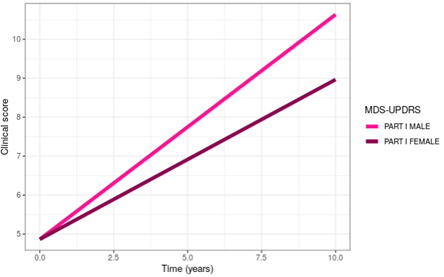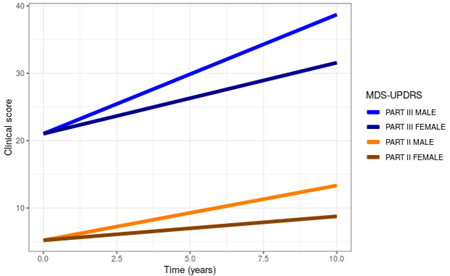Objective: To investigate differences in the progression of motor and non-motor symptoms and striatal degeneration between males and females with Parkinson’s disease (PD).
Background: Biological sex has been acknowledged as an important determinant for both the susceptibility to develop PD and its clinical phenotype. A quantitative framework predicting sex differences in the progression of clinical symptoms and biomarkers is key for the successful development of sex-tailored therapeutic innovations.
Method: We analyzed data from treatment-naive individuals of the Parkinson’s Progressive Markers Initiative with a diagnosis of idiopathic PD, confirmed by a positive DaTSPECT, since baseline and up to a follow-up of 10 years. We compared males vs. females with respect to the progression of (1) non-motor (MDS-UPDRS Part I) (238 males, 121 females) and (2) motor symptoms and experiences of daily living (MDS-UPDRS Part II) (237 males, 122 females), (3) motor signs (MDS-UPDRS Part III) (221 males, 111 females), and (4) DaTSPECT specific binding ratios in the putamen (238 males, 129 females). The time courses of MDS-UPDRS Parts I-III were modeled by a simple linear progression. A mixed-effects modeling framework was used to quantify individual deviations (variability) from the population trend in the progression parameters. The time course of the DaTSPECT data was modeled with exponential decay.
Results: Males showed faster worsening over time in MDS-UPDRS parts I (0.58 pts/yr in males vs. 0.41 pts/yr in females; relative standard error (RSE) of covariate parameter estimate 40%, II (0.41 pts/yr in males vs. 0.35 pts/yr in females; RSE 17%) and III (1.8 pt pts/yr males vs.1.05 pts/yr in females; RSE 26%) than females (see Figures 1 and 2). The progression of DaTSPECT striatal binding ratios did not differ between men and women (RSE 226%).
Conclusion: PD progresses faster in males than females. As a next step, we will explore whether there are differences among subitems/individual symptoms and how the results between MDS-UPDRS and DaTSPECT specific binding ratios relate to each other and might be influenced by baseline differences. Given the lack of differences in the progression of specific binding ratios in the putamen, it remains to be explored whether and how this sex difference is based on differences in the underlying disease pathology and/or in how the MDS-UPDRS is rated in men vs. women.
To cite this abstract in AMA style:
T. Kassuba, B. Ribba, T. Simuni, K. Marek, A. Siderowf, L. Chahine, M. Picillo, P. Brundin, G. Pagano. Clinical progression in males and females with early treatment-naive Parkinson’s disease [abstract]. Mov Disord. 2023; 38 (suppl 1). https://www.mdsabstracts.org/abstract/clinical-progression-in-males-and-females-with-early-treatment-naive-parkinsons-disease/. Accessed December 20, 2025.« Back to 2023 International Congress
MDS Abstracts - https://www.mdsabstracts.org/abstract/clinical-progression-in-males-and-females-with-early-treatment-naive-parkinsons-disease/


